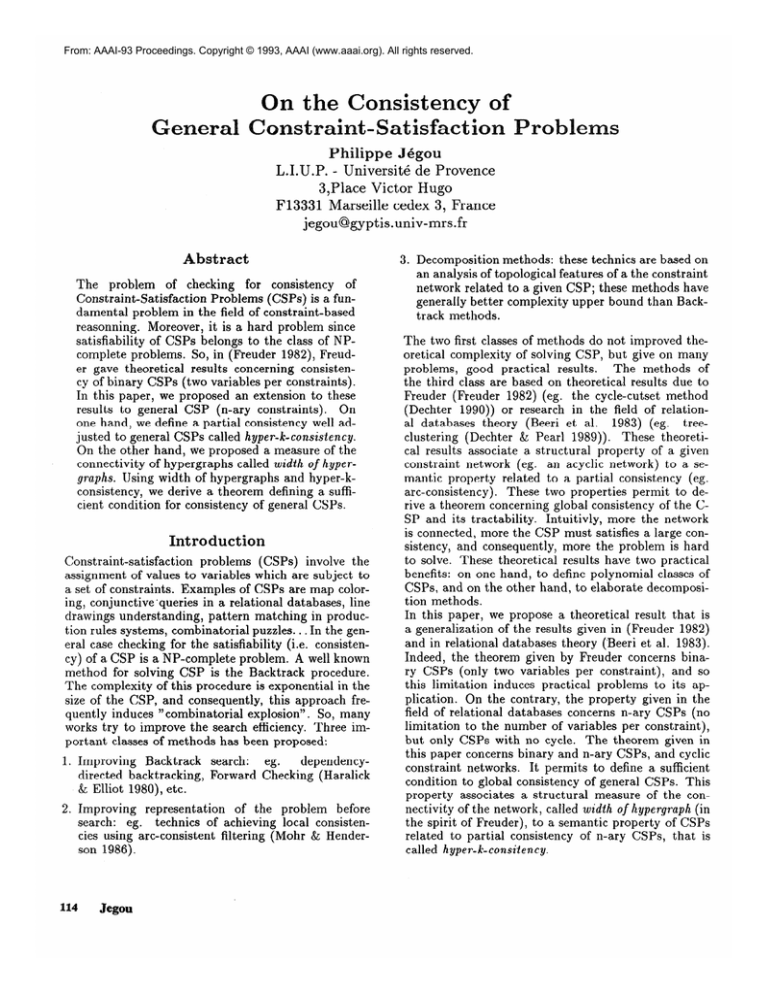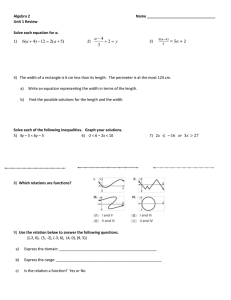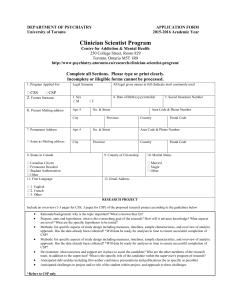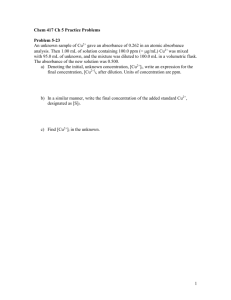
From: AAAI-93 Proceedings. Copyright © 1993, AAAI (www.aaai.org). All rights reserved.
eneral
On the Consistency
raint=Satis
of
S
Philippe Jdgou
L.I.U.P. - Universite de Provence
3,Place Victor Hugo
F13331 Marseille cedex 3, France
jegou@gyptis.univ-mrs.fr
Abstract
The
problem
of checking
for consistency
of
Constraint-Satisfaction
Problems (CSPs) is a fundamental problem in the field of constraint-based
reasonning.
Moreover, it is a hard problem since
satisfiability
of CSPs belongs to the class of NPcomplete problems. So, in (Freuder 1982), Freuder gave theoretical
results concerning
consistency of binary CSPs (two variables per constraints).
In this paper, we proposed an extension to these
results to general CSP (n-ary constraints).
On
one hand, we define a partial consistency well adjusted to general CSPs called hyper-k-consistency.
On the other hand, we proposed a measure of the
connectivity
of hypergraphs
called width of hypergraphs. Using width of hypergraphs
and hyper-kconsistency,
we derive a theorem defining a sufficient condition for consistency of general CSPs.
Introduction
Constraint-satisfaction
problems
(CSPs)
involve the
assignment of values to variables which are subject to
a set of constraints.
Examples of CSPs are map coloring, conjunctive’queries
in a relational databases, line
drawings understanding,
pattern matching in production rules systems, combinatorial
puzzles. . . In the general case checking for the satisfiability
(i.e. consistency) of a CSP is a NP-complete
problem. A well known
method for solving CSP is the Backtrack
procedure.
The complexity of this procedure is exponential
in the
size of the CSP, and consequently,
this approach freexplosion” . So, many
quently induces ”combinatorial
works try to improve the search efficiency. Three important classes of methods has been proposed:
1. Improving
Backtrack
directed backtracking,
& Elliot 1980), etc.
search:
Forward
eg.
dependencyChecking (Haralick
2. Improving
representation
of the problem
before
search:
eg.
technics of achieving local consistencies using arc-consistent
filtering (Mohr & Henderson 1986).
114
Jegou
3. Decomposition
methods: these technics are based on
an analysis of topological features of a the constraint
network related to a given CSP; these methods have
generally better complexity upper bound than Backtrack methods.
The two first classes of methods do not improved theoretical complexity of solving CSP, but give on many
problems,
good practical
results.
The methods
of
the third class are based on theoretical
results due to
Freuder (Freuder 1982) (eg. the cycle-cutset
method
(Dechter
1990)) or research in the field of relational databases
theory (Beeri et al.
1983) (eg.
treeclustering (Dechter & Pearl 1989)).
These theoretical results associate a structural
property of a given
constraint
network (eg. an acyclic network) to a semantic property related to a partial consistency
(eg.
arc-consistency).
These two properties permit to derive a theorem concerning global consistency of the CSP and its tractability.
Intuitivly,
more the network
is connected, more the CSP must satisfies a large consistency, and consequently,
more the problem is hard
to solve. These theoretical
results have two practical
benefits: on one hand, to define polynomial classes of
CSPs, and on the other hand, to elaborate decomposition methods.
In this paper, we propose a theoretical
result that is
a generalization
of the results given in (Freuder 1982)
and in relational databases theory (‘Beeri et al. 1983).
Indeed, the theorem given by Freuder concerns binary CSPs (only two variables per constraint),
and so
this limitation
induces practical problems to its application.
On the contrary, the property given in the
field of relational databases concerns n-ary CSPs (no
limitation to the number of variables per constraint),
but only CSPs with no cycle. The theorem given in
this paper concerns binary and n-ary CSPs, and cyclic
constraint
networks.
It permits to define a sufficient
condition to global consistency of general CSPs. This
property associates a structural
measure of the connectivity of the network, called width of hypergraph (in
the spirit of Freuder), to a semantic property of CSPs
related to partial consistency
of n-ary CSPs, that is
called hyper-k-consitency.
It is known that any non-binary
CSP can be treated
as a binary CSP if one look at the dual representation
or join-graph
(this representation
has been defined in
the field of relational databases:
constraints
are variables and binary constraints
impose equality on common variables).
But this approach if of limited interest:
it does not allow to realize extension of all theorems
and algorithms to non-binary CSPs. For example, the
width of an n-ary CSP cannot be defined exactly as
the width of its join graph (see example in figure 3).
So, original definitions are introduced in this paper.
The second section presents definitions and preliminaries. In the third section, we defined hyper-k-consitency
while in next section we introduce the notion of width
The last section exposes the consisof hypergraphs.
tency theorem and give comments about its usability.
efinitions
Finite
and preliminaries
Constraint-Satisfaction
Problems
A General
Constraint-Satisfaction
Problem involves
a set, X of n variables Xi, X2, . . . X, , each defined
by its finite domain values D1, &, . . . D,, (d denotes
D is
the maximum
cardinality
over all the Di).
C is the set of constraints
the set of all domains.
A constraint
Ci is defined as a set
Cl, (72,. . .c,.
of variables
(Xi,, Xia,. . . Xi,,).
To any constraint, Ci, we associate a subset of the Cartesian product
Di, x . . . x Dijt that is denoted R; (Ri specifies which
values of the variables are compatible with each other;
Ri is a relation, so it is a set of tuples).
R is the set
of all Ri. So, we denote a CSP P = (X, D, C, R). A
solution is an assignment of value to all variables satisfying all the constraints.
Given a CSP P = (X, D, C, R), the hypergraph (X, C)
is called the constraint hypergraph (nodes are varia.bles
and hyper-edges are defined by constraints).
A binary
CSP is one in which all the constraints
are binary, i.e.
only pairs of variables are possible, so (X, C) is a graph
called constraint graph. For a given CSP, the problem
is either to find all solutions or one solution, or to know
if there exists any solution. The decision problem (existence of solution) is known to be NP-complete.
We
Projection of relation,use two relationnal
operators,
s: if X’ E Ci, the projection
of Ri on X’ is denoted
Ri[X'] and join of relations denoted Ri W Rj ; see formal definitions in (Maier 1983).
Partial
consistencies
in CS
Different levels of consistency have been introduced in
the field of CSPs.
The methods to achieve these local consistencies
are considered as filtering algorithms: they may lead to problem simplifications,
without
chaaging the solution set.
They have been used as
well to improve the representation
prior the search, as
t,o a.void backtrack
during the search (Haralick & Elliot 1980).
Historically,
the first partial consistency
proposed was arc-consistency.
given in (Freuder 1978).
Its generalization
was
Definition 1 (Freuder 1978). A CSP is k-consistent iff
for all set of Ic - 1 variables, and all consistent assignments of these variables (that satisfy all the constraints
among them), for all lath variable XI,, there exists a value in the domain & that satisfies all the constraints
among the K variables. A CSP is strongly k-consistent
iff the CSP is j-consistent
for j = 1, . . . k.
Given a CSP and a value k, the complexity
of the
O(nkdk) (Cooper
algorithm achieving k-consistencyis
1989). But achieving k-consistency
on a binary CSP
generally induces new constraints,
with arity equal to
k - 1. Consequently,
a binary CSP can be tranformed
in an n-ary CSP using this method (eg. achieving 4consistency).
An other partial-consistency
has been defined particularly for n-ary CSPs: the pairwise-consistency
(Janssen
(Jegou 1991).
et al. 1989) a 1so called inter-consistency
This consistency
is based on works concerning
relational da.tabases (Beeri et al.
1983).
Whereas
kconsistency
is a local consistency
between variables,
domains and constraints,
inter-consistency
defines a
consistency
between constraints
and relations.
On
the contrary of k-consitency,
that does not consider
structural
features of the constraint
network, interconsistency is particularly adjusted to the connections
in n-ary CSPs, because connections
correspond to intersections between constraints.
Definition 2 (Beeri et al. 1983)(Janssen
et al. 1989).
We said that P = (X, D, C, R) is inter-consistent
iff
VC$Z’~,R$2$6’~]=R#$6’~]andVR~,R~#0.
In (Janssen
et al.
1989)
a polynomial
algorithm
achieving this consistency
is given. This algorithm is
based on an equivalent binary representation
given in
the next section.
Binary
representation
for n-ary
CS
In this representation,
the vertices of the constraint
graph are n-ary constraints
Ci, their domains are the
associated relations Ri, and the edges, that, are new
constraints,
are given by intersections between Ci. The
compatibility
relations are then given by the equality constraints
between the connected Ri. This binary
representation
is called the constraint intergraph associated to a constraint hypergraph (Jegou 1991).
3. A hypergraph H is a pair (X, C) where
Definition
X is a finite set of vertices and C a set of hyper-edges,
i.e. subsets of X. When the cardinality of any hyperedges is two, the hypergraph
is a graph (necessary
undirected).
Given a CSP (X, D, C, R), we consider
its associated hypergraph denoted (X, C).
Comstraht=Based Reason
115
Definition 4 (Bernstein
SC Goodman
1981).
Given
a hypergraph
H = (X,C),
an intergraph of H is a
graph G(H) = (C, E) such as:
o E E ((Ci,Cj)
C C/i#
j and CanCj
# 0)
* VCi, Cj E C, if Ci n Cj # 0, there is a chain (Ci =
Cl, ~32,. . .Cq = Cj) in G(H) such as
Vk,l<k<q,CinCjECknCk+l
Intergraphs
are also called
(Maier 1983) and dual-graphs
line-graphs,
join-graphs
(Dechter si Pearl 1989).
Definition 5 (Jegou 1991). Given a CSP (X, D, C, R),
we defined an equivalent (equivalent sets of solutions)
binary CSP (C, R, E, Q):
o (C, E) is an intergraph
0 c: = {C,,...C,)
domains R = {RI,
of the hypergraph
is a set of variables
. . . R, }.
(S,
C).
defined
on
o if (Ci, Cj} E E, then we have an equality constraint:
Qk = {(ri,Vj)
E Ri x Rj/ri[Ci
nCjJ = rj[Ci f?Cj]}
Given a hypergraph,
it can exists several associa ted intergraphs.
Some of them can contain redundant,
edges that can be deleted to obtain an other intergraph. The maximal one is called representalive
graph.
In the field of CSPs, we are naturally interested with
all edges are necessary, i.e. no
minimal intergraphs:
edge can be deleted conserving the property of chains
in intergraphs.
So an algorithms
have been proposed
to find minimal intergraphs
in (Janssen
et al. 1989).
11 study of combinatorial
properties of minimal intergraphs is given in (Jegou St Vilarem 1993). In the next.
example two minimal intergraphs
are given:
This definition is illustrated
in figure 1: the width of
the graph (1)) is 2 and the width of the graph (c) is 3.
On this example, we can remark that the width of an
hypergraph cannot be defined as the width of its minimal intergraph,
because all minimal intergraphs
has
not the same width.
Theorem
7 (Freuder 1982). Given a CSP, if the level of strong consist5ency is greater than the width of
the const.raint graph, then the CSP is consistent
and
it is possible to find solutions without backtracking
(in
polynomial time).
Freuder also gave an algorithm to compute the width of
any graph (in O(n+?n)).
So given a CSP, it is sufficient to know the width of the constraint
graph, denoted
b - 1, then to achieve k-consistency.
But a problem
appears: tohis approach is possible only for acyclic constraint graphs (width equal to one) and a subclass of
graphs the width of which is two (called regular graphs
of width two in (Dechter ti Pearl 1988)).
The cause
generally inof t,hat problem: achievin g k-consistency
duces nary constraints
(arity can be equal to k - l), so
the corresponding
problem is a const5raint hypergraph,
aud the t.heorem can not be applied.
Nevertheless,
the result concerning
acyclic CSPs is applied in the
cycle-cutset, method (Dechter 90) and we can consider
Freuder’s t.heorem as a vehicle to give a lower bound
for complexity
of a binary CSP: to the order of cl” if
its width is k - 1, because complexity of achieving kcoiisist,ency is O( ?z’cl” ) (Cooper 1989).
A result
of relational
A similar property
latioual databases.
hypergraphs.
theory
has been derived in the field of reThis property is related to acyclic
Definition
is acyclic
database
8 (Beeri et al.
iff 3 a. linear order
1983).
A hypergraph
(Cl, Cz, . . . Cm) such as
nU~l’,C~) E Cj, (this propinfers&?o:n
property)
Vi, 1 < i 5 m. 3ji < i/(Ci
erty is called
Figure
1. Hypergraph
A sufficient
(a) and two minimal
condition
for CSPs
runntllg
intergraphs.
consistency
Freuder has identified sufficient conditions for a bina.ry CSP to satisfy consistency,
ie. satisfiability.
These
conditions associate topology of the constraint
graph
with partial consistency.
Definition 6 (Freuder 1982). An ordered constraint
graph is a constraint graph in which nodes are linearly
ordered. The width of a node
that link that node to previous
order is the maximum width of
n gmph is the minimum width
graph.
116
Jegou
is the number of edges
nodes. The width of an
all nodes. The width of
of all orderings of that
Figure
2. Cyclic (a) and acyclic (b) hypergraphs.
(Beeri et al. 1983) gave a fundamental
property of
acyclic database schemes that concerns consistency
of
such databases,
namely global consisfency.
This result
is presented below using CSPs terminology:
Definition
9.
Let P
= (S, D, C, R) be a CSP.
We
say that P is globally consistent if there is a relation S over the variables X (S is the set of solutionIt is equivs) such as Vi, 1 5 i 5 m, Ri = S[Ci].
alent to Vi, 1 5 i 5 m, (D$El Rj)[Ci]
= Rd since
S = (WY& Rj).
Note that global consistency
of CSPs implies satisfiability of CSPa.
Indeed, a CSP is globally consistent
iff every tuple of relations appears at least in one solution. Furthermore,
it is clear that global consistency
implies inter-consistency
but the converse is false. We
give the interpretation
in the field of CSP to the property given by (Beeri et al. 1983):
Theorem
10 (Beeri et al. 1983).
its constraints
hypergraph is acyclic,
P is inter-consistent
e
If P
then
P is globally
is such as
consisient.
An immediate
application
of this theorem concerns
the consistency
checking of CSPs.
We know polynomial algorithms
to achieve inter-consistency
while to
check global consistency
is a NP-complete
problem.
So, knowing this theorem, if the database scheme is
acyclic, it is possible to check global consistency
in a
polynomial time achieving inter-consistency.
This result is applied in the tree-clustering
method (Dechter
& Pea.rl 1989).
Some
remarks
Theorems 7 and 10 are significant.
First, they can be
used to solve CSP, immediatly
if the considered CSP
is acyclic, or for all CSP, using decomposition
methods
as the cycle-cutset
method, or tree-clustering
scheme.
Second, because they define polynomial subclasses of
CSPs. Nevertheless, there is two significant limitations
to these theoretical
results.
On one hand, theorem 7
is only defined on binary CSPs, and so, it can not be
a.pplied, nor on n-ary CSPs, nor on constraints
graph
with width greater than 2. On the other hand, theorem
11 concerns only acyclic n-ary CSPs. So, a genera.lization to cyclic n-ary CSPs is necessary to extend this
kind of theoretical
approach to all CSPs.
A new consistency fcmrwary
yper-k-consistency
CS
When Freuder defined k-consistency,
the definition is
“given a consistent assignment
related to assignments:
of variables Xi, X2, . . . Xk- 1, it is possible to extend
this assignment
for all kth variable”.
To generalize
k-consistency
to n-ary CSPs, we consider the same a.pproach but with constraints and relations: we can consider ” assignment” of constraints
Cl, Cz, . . . Ck- 1, and
their extension to any kth constraint.
Our definition
of hyper-k-consistency
is given in this spirit:
Definition
k-consistent
($;lj
11.
A CSP P = (X, D, C, R) is hyperiff VRi, Ri # 0 and VCi, Ca, . . .Ck-1 E C,
Ri)[(&;
Ci) n Ck] c Rk[(&$i)
P is strongly hyper-k-consistent
hyper-i-consistent.
iff Vi, 1 5 i 5 k, P is
We can note that hyper-2-consistency
is equivalent to inter-consistency.
So, hyper-k-consistency
constitutes really a generalization
of inter-consistency
to
greater levels.
Actually, this definition can be considered as a formulation
of k-consistency
on the constraint
intergraph:
(Wfi,’ ri)~(D$z:
Ri) signifies
that (~1, ~2,. . . rk-1) is a consistent assignment of constraints Cl, C2, . . . Ck - 1, and if there is rk E Ra such
as:
then (q, r2,. . . v-k-1, rk) is a consistent assignment of
i.e. k variables of the
constraints
Cl, C2, . . . Ck-l,C’k,
This particularity
induces a
constraint
intergraph.
method to achieve hyper-k-consitency,
that is based
on the same approach of achieving k-consistency
on
binary CSPs. So, we have the same kind of problems:
achieving hyper-k-consistency
can modified constraint
hypergraph.
A second problem concerns the complexity of achieving hyper-k-consistency:
the complexity is
in the order of rk if r is the maximum size of Ri. These
problems are discussed in (Jegou 1991).
Another remark about hyper-k-consistency
concerns
its links with global consistency;
we easily verify that
if a CSP P is hyper-m-consistent,
then P is globally
consistent while the converse is generally false.
The definition of hyper-k-consistency
in n-ary CSP
concerns connections in hypergraphs,
i.e. intersectionSo the definition of width of
s between hyper-edges.
hypergraph is based on the same principles.
Connections
in hypergraphs concerns intersections
between hyper-edges.
So, the consistency of a n-ary CSP
is intimately
connected
to the intersections
between
hyper-edges.
The definition of width of hypergraph
allows us to define a degree of cyclicity of hypergraphs. Using this width, we shall work out links between
structural
properties
of hypergraphs
and the global
consistency of n-ary CSPs.
Before to give our definition of the width of an hypergraph, we must explain why this definition is not
immediatly related to intergraphs.
A first reason has
already been given: all minimal intergraphs of a. hypergraph have not necessary the same width (see figure 1).
An other rea.son is the next one: if we define the width
of an hypergraph as the width of one of its intergraph
(not necessary a minimal one), we cannot obtain the
same properties than we have with Freuder’s theorem
that is based on a good order for the assignment of the
variables:
n Ck]
Constraint-Based
Reasoning
117
e 3order (Cl, C2,. . . C,,,) such as Vi, 1 < i 5 m,
1 {cincj/j
< ir\+lk, k < i/CiflCj
C# CinCk)
I< 1
e 3order (Cl, Cz, . . .C,,,)/L&)
5 1 @ L(H) 5 1:
Moreover,
it is clear that if H is connected and if
C possesses naore than one hyper-edge,
the inequality L(H) 2 1 necessary holds.
Figure 3. Problem of order on variables.
The hypergraph considered in the figure 4 is the one
of the figure 1. We consider two possible orders on this
intergraph.
The first one is not a possible order for the
assignment of the variables.
Indeed, when the variable
corresponding
to C’s is assigned, the variable 1 of the
hypergra.ph has already been assigned and so, it is possible to assign Ca with an other value for 1. This is
possible because C2 is given before C’s in the order a.nd
because there is no edge between C2 and Ca. So, we
can obtain two different assignments
for the variable
1, and finally, we can obtain a consistent
assignment
. C’s, and consequently
an assignment on
011 C1,C&..
variables Xi, X2, . . . Xc that is not a solution of the
problem. The second order of width 3 does not induce
such problems.
Given a hypergraph
H = (S, C),
Definition
12.
0 the set of linear orders on C, and a linear order
T=(cl,.
..c~)EO:
the *width of Ci in order r on H is the number of
maximal intersections
with predecessors
of Cd in r;
&(Ci)
denots the width of Ci in order r: C,(Ci)
=
I{C~nCj/j<ir\l3k,k<i/CinCj
c#CinCk}
1
the luidth ofr
is ,!ZH(~) = ma2
the width of H is E(H)
= min
{LT(Ci)/Ci
{L~(r)/r
E C)
E 0)
Order
Cl
c3
c4
c5
c2
Figure 4. Width of the hypergraph.
Proposition
13. H is acyclic e L(H) = 1
Proof.
H acyclic satisfies the running
intersection
property
H 3order (Cl, (2’2,. . .C,,-,) such as
Vi, 1 < i 5 m, 3ji < i/(Ci n( Ui;iCk)
) C Cj,
Jegou
Consistency
Theorem
In t,his section, we derive a sufficient condition to consistency of general CSPs. This condition concerns the
width of the hypergraph
associated
to the CSP, a.nd
the hyper-k-consistency
that the relations satisfy (i.e.
the value k).
Theorem
14. Let P = (X, D, C, R) be a CSP and
and if
H = (S, C). If P is strongly hyper-k-consistent,
L(H) 2 k - 1, then P is consistent.
We mast show that P is consistent,
i.e.
Proof.
Vi, 1 5 i 5 m,3ri
E Ri/(w~?.,
ri) E (WEI
Ri).
That is (rl, rz,. . .rm) can be considered as a consistent assignment
on (Cl, C?, . . .C,):
Vi, j, 1 5 i, j 5
m, ri [Ci n Cj] = Tj [Ci n Cj].
We proove this property by induction on p, such as
1 Lps
m..
IfP
In the fugure 4, we see the width of the hypergraph H given in figure l-a.
Here, CH(~) = 3 since
&({3,5,6})
= 3; we can verify that VT E 0, LN( T) =
3, and consequently
that ,!Z(H) = 3. A property relies
width and cyclicity:
118
Given a hypergraph
(X, C) and an order on C, it is
not hard to find the width of this order.
It is just
necessary to compute for each Ci the number of maximal intersections
with predecessors,
and to select the
011 the contrary, finding an order that give
greater.
the minimal width of a hypergraph
is an optimization
problem; this problem seems us to be open concerning
its complexity:
does it belong to NP-hard problems ?
This question is at present an open question. In (JCgou
1991), an heuristic is proposed to find small width, ie.
just an approximation
of the width of a given hypergraph.
= 1, the property
trivially holds.
We consider now a linear order (Cl, (2’2,. . . Cm) associated to the width t(H)
5 k - 1. Suppose that the
property holds for p - 1 such as 1 < p 5 m. That is
we have (rl , rz, . . . rp--l)/Vl:, 1 5 i 5 p - 1, ri E Ri and
Vi,j,l<i,j<p-l,r&XCj]=rj[CinCj].
By definition of the width, C,, possesses at most k - 1
maximal intersections
with predecessors
in the order.
Ci, be the corresponding
Ci, with necLet Cil,Cj2,...
only one Ci for evessary q 5 k - 1, considering
ery maximal intersection.
Q being strongly hyper-kconsistent, and since q 5 k - 1, we have
(WY=1Rij)[(U~=,Cij)
n C,] E RP[(Ul,1Ci,)
and for the ri, ‘s appearing
n C,]
in. (r1 , 1.2, . . . rP--l )
(W&l Ti,)[(U~=lCi,) n Cp] E Rp[(UjQ=tCiJ1n Cpl
so, 3-p
(7’21)
. Pi2,.
rP[Cij n
..
E
rip),
RP such as rP is consistent
with
that is: Vj, 1 5 j 5 Q, rij[Ci, n C,] =
C,].
We show now, that rP is also consistent
ri ‘s, i. e. ra[Ci n C,] = rP[Ci n C,] .
for all the
eferenees
Consider Ci such as 1 < i < p and C; n Cp # 0.
By the definition of the width, 3j, 1 < j 5 q such
as Ci n CP C Cij n CP because the CijTs are maximal
for the intersection
with CP. Consequently,
we have
CinCP
E CinCjj.
By hypothesis, we have rd[Ca n Cij] = ri,[Ci n Cd,],
a fortiori,
we have ri[Cd n C,] = rij[Ci n C,]. We
seen that rij [Cij nCp] = rP[Cij n CP]; this emplies that
ri, [Ci n C,] = rP[Cs n C,]. Consequently,
ri[Ca n C,] =
raj [Ci n C,] = rP[Cj n C,]. So, (rl,rl,.
. .rP-l,rP)
is
consistent assignment on (Cl, C2, . . . C,_l, C,>.
So the property
consistent.
holds for p, and consequently,
et al. 1983), and not as a directly usable result.
The next research must be to exploit the theorem, on
one hand to try to find new polynomial classes of CSP, and on the other hand to propose new methods to
solve practically n-ary CSPs.
P is
M.
Beeri, C., Fagin, R., Maier, D. and Uannakakis,
1983. On the desirability of acyclic database schemes.
Journal of the ACM 30:479-513.
Dechter, R. 1990. Enhancement
Schemes fo Constraint Processing:
Backjumping,
Learning and Cutset DeArtificial Intelligence 41:273-312.
composition.
Dechter, R. and Pearl, J. 1988. Network-based
heuristics for constraint satisfaction
problems.
Artificial Intelligence 34~1-38.
Dechter, R. and Pearl,
Constraint
Networks.
J. 1989.
Artificial
Tree Clustering
for
Intelligence
38:353-
366.
If we recall the property given about acyclic database
schemes (Beeri et al. 1983), it is clear that theorem 10
is a corollary of theorem 14 (because k = 2). A more
interesting result is the next corollary:
Freuder, E.C. 1978.
Synthesizing
constraint
expressions. Communications
of the ACM 21:958-967.
Corollary
15. Let P = (X, D, C, R) be a CSP such
as (X, C) is a graph (i.e. all hyper-edges have cardinality 2). If P is strongly hyper-3-consistent,
then P
is consistent.
Proof.
It is suficient
to remark that if (X, C) is a
graph, its width is at most 2, because a/l hyper-edges
of (X, C) are edges, and an edge has no more than 2
maximal intersections.
32.
Nevertheless, this surprising corollary is not allways usable, because achieving hyper-k-consistency
can modify the hypergraph associated to a n-ary CSP. Freuder’s
theorem has the same kind of problems: try to obtain
its preconditions
can modify these preconditions.
So,
concerning the practical use of the theorem, a problem
is given by the verification of hyper-k-consistency
in a
CSP. On one hand, the theorem gives a sufficient condition to consistency,
and not a necessary condition;
on the other hand, given a value k, it is possible to
obtain hyper-k-consistency
using filtering mecanisms
(J&go*& 1991) in polynomial
time in k, in the size of
the CSP. But this process can modify the hypergraph
with a.dditions of new hyper-edges,
and so modify the
width.
Nevertheless,
contrary to Freuder’s theorem,
the consistency
theorem can be tried to apply after
modification of the width because it is directly defined
on n-ary CSPs.
Consequently,
the theorem must be considered in a first
time as a theoretical result, with, at this moment, only
one practical application:
the corollary given in (Beeri
Freuder,
E.C.
1982.
backtrack-free
search.
A sufficient
condition
for
Journal of the ACM 29(1):24-
Ha.ralick, R.M. and Elliot, G.L. 1980. Increasing tree
search efficiency for constraint-satisfaction
problems.
Artificial Intelligence 14:263-313.
Janssen, P., J&gou, P., Nouguier, B. and Vilarem, M.C.
1989. A filtering process for general constraint
satisfaction problems: achieving pairwise-consistency
using
an associated binary representation.
In Proceedings of
the IEEE Workshop on Tools for Artificial Intelligence,
420-427. Fairfax, USA
Jkgou, P. 1991. Contribution
8. l’&ude des probE?mes
de satisfaction
de contraintes. . . Thbse de Doctorat, Universitk Montpellier II, France.
Jegou, P. and Vilarem, M.C. 1993. On some partial
line graphs of a hypergraph
and the associated
matroid. Discrete Mathematics.
To appear.
Maier, D. 1983. The Theory
es. Computing Science Press.
of Relational
Databas-
Mohr, R. and Henderson,
T.C. 1986. Arc and path
consistency revisited. Artificial Intelligence 28(2):225-
233.
Constraint-Based
Reasoning
PI9





